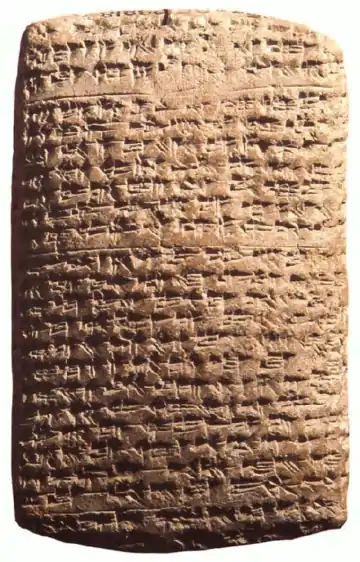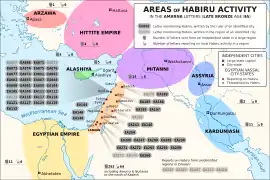Amarna letter EA 299
Amarna letter EA 299, titled: "A Plea for Help"[1] is a fairly short clay tablet Amarna letter from "governor" Yapahu of city-state Gazru. The clay tablet surface has been partially eroded, but the cuneiform is still mostly legible.
_to_the_Egyptian_pharaoh_Amenhotep_III_or_son_Akhenaten.jpg.webp)

The tablet is medium in color (lt tan—medium lt chocolate: (see here: )) and is about 12 cm tall, and a wide tablet, about 8.5 cm. The tablet is located in the British Museum, no. 29832.
The Amarna letters, about 300, numbered up to EA 382, are a mid 14th century BC, about 1360 BC and 30–35 years later, correspondence. The initial corpus of letters were found at Akhenaten's city Akhetaten, in the floor of the Bureau of Correspondence of Pharaoh; others were later found, adding to the body of letters.
The letter
EA 299: "A Plea for Help"
EA 299, letter number three of four from Yapahu of Gazru. (Not a linear, line-by-line translation.)[2]
Obverse (See here: ) (or High Def: )
- Paragraph I
- (Lines 1-11)—To the king, my lord, my god, the Sun, the Sun [f]rom the sky: Message of Yapahu, the ruler of Gazru, your servant, the dirt at your feet, the groom of your horses. Truly I fall at the feet of the king, my lord, my god, my Sun, the Sun from the sky, 7 times and 7 times, on the stomach and on the back.
- Paragraph II
Akkadian & Cuneiform text
- Paragraph I
- (Line 1)—A-na[3] diš-lugal-EN-ia dingir-meš-ia–( To Diš-King-Lord-mine, (of) dGod(S)-mine.. )
- (2)—{d}-meš-ia {d}-utu ša iš-tu–.–.–.–.–.–.–( dGod{S}-mine, dSun-God, .. Which .. From .. )
- (3)—an-{ša10-me} um-ma diš-Ya-Pa-iYa–.–(..{d}-Sky; --///-- Message 1-Yapahu ! ..)
- (4)—LÚ ša iri-GaZ-Ri-ki–.–.–.–.–.–( Man(Governor), .. "Which-(of)" iri-GaZRu-ki !! ) ( Town-GaZRu-ki )
- (5)—ARAD2-ka ep-ri ša giri3-meš-ka–(.. Servant-yours, .. "The Dirt" Which-(at) Feet(S)-yours .. )
- (6)—LÚ-ku8-sí anše-kur-ra-meš
- (7)—a-na 2(diš) giri3-meš Lugal-EN-ia
- (8)—dingir-meš-ia {d}-utu-ia {d}-utu
- (9)—ša iš-tu an-{ša10-me} 7(diš)-šu
- (10)—u 7(diš)-ta-a-an lu-ú am-qut-ma
- (11)—ka-bat-tum u s,e-ru-ma
- Paragraph II
The Habiru/'Apiru

The mention of the Habiru shows the conflict of the time, as the takeover of city-states or regions by the Habiru. The map shows various cities and regions, and their respective dealings with the Habiru. (There are only 3 letters from Labaya of Šakmu/Shechem.) The next closest mention of the Habiru is from the Jerusalem letters of Abdi-Heba, directly south at Jerusalem, letters EA 286, 287, 288, 289, and EA 290.
Spellings for Habiru in the Amarna letters
- EA 100, l. 26—KUR,.. ša ìl-qú LÚ.MEŠ GAZ,.. [ ištu ]–.]–( LÚ-MEŠ GAZ )
- EA 271, l. 16—..lú-meš Sa-GaZ-meš .. ( Men (pl), SA.GAZMEŠ(pl)
- EA 290, l. 24—..Ha-Pí-Ri .. ( Hapiru ( 'Apiru ))
- EA 299, l. 18—..da-an-nu LÚ-SA-GAZ-meš .. ( "Strengthening" - LÚ.SA.GAZ.MEŠ ..( "Strengthening Habiru" )
- EA 366, l. 21—.. {LÚ} SA-GAZ .. ( LÚSA-GAZ (Habiru))
References
- Moran, William L. 1987, 1992. The Amarna Letters. EA 158, "A Plea for Help", pp. 340-341.
- Moran, William L. 1987, 1992. The Amarna Letters. EA 299, "A Plea for Help", pp. 340-341.
- EA 299 cuneiform text, CDLI (Digital Library)
- EA 299 cuneiform text, CDLI (Digital Library)
External links
- Line drawing of EA 299, Obverse & Reverse
- Line Drawing, cuneiform, and Akkadian, EA 299: Obverse & Reverse, CDLI no. P270934 (Chicago Digital Library Initiative)
- CDLI listing of all EA Amarna letters, 1-382
- Moran, William L. The Amarna Letters. Johns Hopkins University Press, 1987, 1992. (softcover, ISBN 0-8018-6715-0)